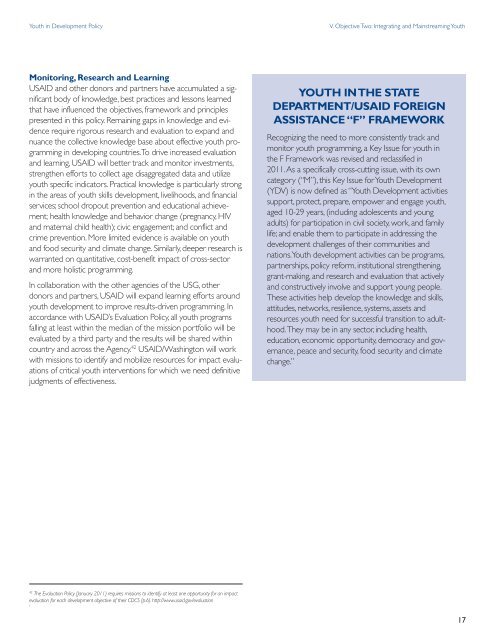YOUTH IN DEVELOPMENT Realizing the Demographic Opportunity USAID POLICY YOUTH
YOUTH IN DEVELOPMENT Realizing the Demographic Opportunity USAID POLICY YOUTH
YOUTH IN DEVELOPMENT Realizing the Demographic Opportunity USAID POLICY YOUTH
Create successful ePaper yourself
Turn your PDF publications into a flip-book with our unique Google optimized e-Paper software.
Youth in Development Policy V. Objective Two: Integrating and Mainstreaming Youth<br />
Monitoring, Research and Learning<br />
<strong>USAID</strong> and o<strong>the</strong>r donors and partners have accumulated a significant<br />
body of knowledge, best practices and lessons learned<br />
that have influenced <strong>the</strong> objectives, framework and principles<br />
presented in this policy. Remaining gaps in knowledge and evidence<br />
require rigorous research and evaluation to expand and<br />
nuance <strong>the</strong> collective knowledge base about effective youth programming<br />
in developing countries.To drive increased evaluation<br />
and learning, <strong>USAID</strong> will better track and monitor investments,<br />
streng<strong>the</strong>n efforts to collect age disaggregated data and utilize<br />
youth specific indicators. Practical knowledge is particularly strong<br />
in <strong>the</strong> areas of youth skills development, livelihoods, and financial<br />
services; school dropout prevention and educational achievement;<br />
health knowledge and behavior change (pregnancy, HIV<br />
and maternal child health); civic engagement; and conflict and<br />
crime prevention. More limited evidence is available on youth<br />
and food security and climate change. Similarly, deeper research is<br />
warranted on quantitative, costbenefit impact of crosssector<br />
and more holistic programming.<br />
In collaboration with <strong>the</strong> o<strong>the</strong>r agencies of <strong>the</strong> USG, o<strong>the</strong>r<br />
donors and partners, <strong>USAID</strong> will expand learning efforts around<br />
youth development to improve resultsdriven programming. In<br />
accordance with <strong>USAID</strong>’s Evaluation Policy, all youth programs<br />
falling at least within <strong>the</strong> median of <strong>the</strong> mission portfolio will be<br />
evaluated by a third party and <strong>the</strong> results will be shared within<br />
country and across <strong>the</strong> Agency. 42 <strong>USAID</strong>/Washington will work<br />
with missions to identify and mobilize resources for impact evaluations<br />
of critical youth interventions for which we need definitive<br />
judgments of effectiveness.<br />
42 The Evaluation Policy (January 2011) requires missions to identify at least one opportunity for an impact<br />
evaluation for each development objective of <strong>the</strong>ir CDCS (p.6). http://www.usaid.gov/evaluation<br />
‘<br />
<strong>YOUTH</strong> <strong>IN</strong>THE STATE<br />
DEPARTMENT/<strong>USAID</strong> FOREIGN<br />
ASSISTANCE “F” FRAMEWORK<br />
Recognizing <strong>the</strong> need to more consistently track and<br />
monitor youth programming, a Key Issue for youth in<br />
<strong>the</strong> F Framework was revised and reclassified in<br />
2011.As a specifically crosscutting issue, with its own<br />
category (“M”), this Key Issue forYouth Development<br />
(YDV) is now defined as “Youth Development activities<br />
support, protect, prepare, empower and engage youth,<br />
aged 1029 years, (including adolescents and young<br />
adults) for participation in civil society, work, and family<br />
life; and enable <strong>the</strong>m to participate in addressing <strong>the</strong><br />
development challenges of <strong>the</strong>ir communities and<br />
nations.Youth development activities can be programs,<br />
partnerships, policy reform, institutional streng<strong>the</strong>ning,<br />
grantmaking, and research and evaluation that actively<br />
and constructively involve and support young people.<br />
These activities help develop <strong>the</strong> knowledge and skills,<br />
attitudes, networks, resilience, systems, assets and<br />
resources youth need for successful transition to adulthood.They<br />
may be in any sector, including health,<br />
education, economic opportunity, democracy and governance,<br />
peace and security, food security and climate<br />
change.”<br />
17


